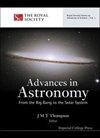基于更快R-CNN的单波长和多波长日冕调光和日冕波检测
IF 1.6
4区 物理与天体物理
Q3 ASTRONOMY & ASTROPHYSICS
引用次数: 3
摘要
太阳事件的自动探测,特别是日冕变暗和日冕波等罕见事件的自动探测,在太阳物理研究中具有十分重要的意义。CD和CW不仅与日冕物质抛射(cme)的探测有关,而且对空间天气也有影响。在本文中,我们研究了自动检测它们的方法。此外,我们还收集和处理了一个包含太阳图像和事件记录的数据集,其中太阳图像来自太阳动力学天文台(SDO)的大气成像组件(AIA),事件记录来自太阳物理事件知识库(HEK)。与之前使用的方法不同,我们引入了深度学习的思想。我们基于Faster R-CNN训练单波长和多波长模型。在精度方面,单波长模型表现更好。多波长模型对多个太阳事件的探测性能优于单波长模型。本文章由计算机程序翻译,如有差异,请以英文原文为准。
Single and Multiwavelength Detection of Coronal Dimming and Coronal Wave Using Faster R-CNN
Automatic detection of solar events, especially uncommon events such as coronal dimming (CD) and coronal wave (CW), is very important in solar physics research. The CD and CW are not only related to the detection of coronal mass ejections (CMEs) but also affect space weather. In this paper, we have studied methods for automatically detecting them. In addition, we have collected and processed a dataset that includes the solar images and event records, where the solar images come from the Atmospheric Imaging Assembly (AIA) of Solar Dynamics Observatory (SDO) and the event records come from Heliophysics Event Knowledgebase (HEK). Different from the methods used before, we introduce the idea of deep learning. We train single-wavelength and multiwavelength models based on Faster R-CNN. In terms of accuracy, the single-wavelength model performs better. The multiwavelength model has a better detection performance on multiple solar events than the single-wavelength model.
求助全文
通过发布文献求助,成功后即可免费获取论文全文。
去求助
来源期刊

Advances in Astronomy
ASTRONOMY & ASTROPHYSICS-
CiteScore
2.70
自引率
7.10%
发文量
10
审稿时长
22 weeks
期刊介绍:
Advances in Astronomy publishes articles in all areas of astronomy, astrophysics, and cosmology. The journal accepts both observational and theoretical investigations into celestial objects and the wider universe, as well as the reports of new methods and instrumentation for their study.
 求助内容:
求助内容: 应助结果提醒方式:
应助结果提醒方式:


